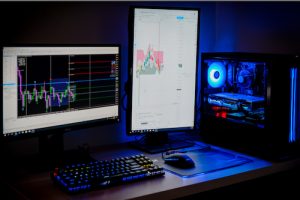The World’s Most Successful Investor Is a Swing Trader

- Swing trading has made many a hedge fund manager a fortune – including the world’s most successful investor.
- Today, Nicholas Vardy shares how this man built his fortune and how swing trading can work for small investors too.
Yesterday, I revealed how billionaire Paul Tudor Jones II made his fortune by swing trading.
Swing trading techniques helped Tudor Jones build his hedge fund from a tiny $30,000 startup to a $7.8 billion leader in the industry.
But Tudor Jones isn’t alone.
I’ve also written about the world’s greatest investor, mathematics professor Jim Simons, who founded Renaissance Technologies in 1982.
Since 1988, Simons’ Medallion Fund has generated average annual returns of 66% before fees.
Bloomberg has called Simon’s quant system “a money printing press.”
But Simons experienced extraordinary success only after he began to focus on identifying reliable and repeatable short-term patterns in the market in 1990.
Today, Simons works with an army of rocket scientists who spend their lives mining reams of data going back to the 1700s to pick stocks.
For Warren Buffett, the ideal holding period for an investment is “forever.”
For the Medallion Fund, the average holding period is two days.
The surprising conclusion?
Simons, the most successful investor in history, is a swing trader.
What a Successful Swing Trade Looks Like
Let’s look at some examples of the kinds of successful swing trades that made Simons a billionaire.
Take a look at the candlestick stock chart below.
As I’ve discussed before, candlesticks offer a wealth of information on where a stock is headed next.

Remember, what swing traders are looking for is streaks. They want to identify periods where every day is the same color.
So you see a stock go red, red, red many days in a row because traders are trading in lockstep… pushing the stock down… But then the reversal happens.
All it takes is one upward swing, and suddenly the machines have completely altered course.
They swing back to buying instead of selling.
When this happens, the days afterward all go green.
Let’s look at another example.
You can clearly see here that this stock suffered several big consecutive down days.
The candlestick chart shows successive bars of red.

But then the stock reverses.
You see the reversal with the first green bar. And then you see the swing higher.
On this swing trade, you could’ve made 125% in nine days.
Here’s another example…

You see a drop of six consecutive days. Then you have a reversal day, followed by the inevitable swing upward.
This single trade would’ve made 104% in under a week
In all these examples, you are seeing algorithmic trading in action.
Again, the quant algorithms are programmed to pick up similar patterns.
They often operate in lockstep. So when one trading system is selling, most of the others are too.
Then, as the sentiment swings in a positive direction, the same stocks rebound, almost as predictably as day follows night.
I use sophisticated software similar to what the biggest hedge funds use.
If my computers switch to buying from selling, it is very likely that the other computers are doing the exact same thing.
Once you know what to look for, it becomes straightforward to predict these movements.
All this is invisible to most investors. But computers programmed with the right algorithm can recognize these patterns in milliseconds.
Two More Edges to Swing Trading
Previously, I’ve discussed why swing trading offers you several edges over other forms of trading. Here are two more advantages…
First, swing trading removes human emotion from trading.
The human mind was not designed for trading. Humans are driven by emotions that can change on a whim.
In contrast, machines are completely predictable. Program a computer with an algorithm, and it will make the exact same decisions every time.
The good news is these algorithms have made Wall Street trading far more predictable than ever before. After Wall Street’s quant algorithms push a stock lower, it’s all but inevitable you’ll see a swing higher as those same computers push it higher.
It’s like Isaac Newton’s third law: For every action, there is an equal and opposite reaction.
Second, swing trading works in any market. Up. Down. Sideways.
I don’t worry about what the overall market is doing. Instead I stay completely focused on the swings of individual stock prices.
Good investing,
Nicholas







11 Comments
[…] succeed in swing trading, you need to choose stocks that are relatively calm and not excessively volatile. Don’t look […]
[…] Read More: The World’s Most Successful Investor Is a Swing Trader […]
[…] https://dev2.investmentu.com/swing-trading-worlds-most-successful-investor/ […]
[…] trading can be a profitable strategy for traders who are adept at using technical analysis , and it has the potential to work in both […]
[…] trading pattern: swing traders look for stocks that show a repetitive pattern in the market They consider a repetitive trend more […]
[…] Entry Point Analysis®, SEPA® is a highly disciplined stock trading strategy developed by Mark Minervini. The methodology’s foundation is built upon historical precedent […]
[…] it enough to make you rich? Swing trading can definitely make you rich With an average annual return of around 30%, you would double your capital every three years, which will grow to huge amounts […]
[…] Who is the most successful swing trader? […]
[…] Who is the most successful swing trader? […]
[…] https://dev2.investmentu.com/swing-trading-worlds-most-successful-investor/ […]
[…] Successful swing traders often have a limited number of large profits. […]
Comments are closed.